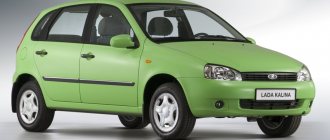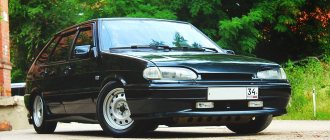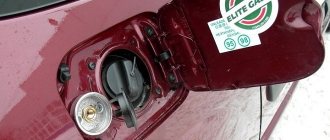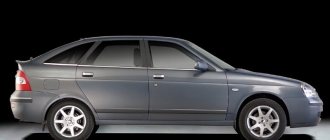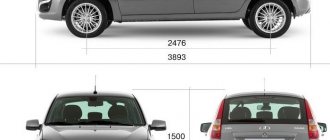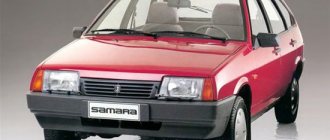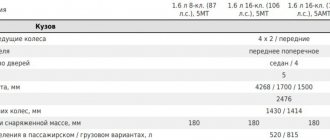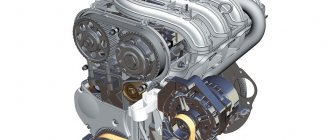The modern appearance of the VAZ-2114 car is given by moldings along all sides, a spoiler with a brake light and door sills. External changes to the VAZ-2114 justify themselves, giving the car excellent aerodynamic qualities, as well as road stability even at high speeds. Bumpers, moldings and other attached parts are designed in the same color scheme as the body, or are made in black, which gives the VAZ-2114 model a resemblance to foreign cars and gives buyers the opportunity to choose the design of the car’s exterior. The car is equipped with electric windows, tinted windows, fog lights, heated seats, central door locking, and alloy wheels.
Decorating the interior with tweed or velor or other material is good for cleaning and does not look dirty. Most car owners who care about the attractiveness of their car still wear covers. The seats of the VAZ-2114 fold out, while the front seats turn into places to rest, which will come in handy if you decide to spend the night on the road. The back of the rear seat is lowered, the car is transformed into a cargo-passenger version, similar to a “station wagon,” due to which a single space is formed with the luggage compartment. The VAZ-2114 is very convenient to transport luggage or medium-sized items.
The VAZ-2114 has a more elaborate and stylish, compared to the “nine”, instrument panel - “European panel” (the upper part does not have a glove compartment, which increases strength and reduces the occurrence of extraneous noise), a new instrument panel with an on-board computer function (shows the temperature overboard, voltage in the on-board network, current time and other parameters). The steering column is shorter than that of the predecessors of the VAZ-2114, it is adjustable in angle, which allows you to adjust it to the individual characteristics of the drivers and conveniently drive the car without getting tired on long journeys, the steering wheel of the “tenth” family. Heating of the VAZ-2114 interior is provided by a new, more functional design of the system with a filter that protects against dust, without a coolant tap. Available in 2 trim levels - “Standard” or “Luxury”. Externally, the “luxury” versions are distinguishable from the “standard” ones only by fog lights and wheel caps. In the interior there are headrests for the rear sofa. In addition, the seats and doors have more pleasant (but at the same time easily soiled) upholstery, and instead of a plug on the center console, there is a trip computer that records fuel consumption, travel time and average speed.
Since 2007, the car has been equipped with a new 1.6-liter engine (VAZ-11183) of the Euro-3 environmental class, the model received the VAZ-21144 index. Distinctive features from the old engine - the catalyst is located not under the bottom, but near the engine, a plastic decorative cover is put on the engine, instead of an aluminum receiver, a plastic one is installed.
In 2008, there were minor changes in styling, namely: instead of thick moldings, “narrow” moldings began to be installed on the doors.
In 2009, a subsidiary of AvtoVAZ OJSC, Super-Avto CJSC, modernized the VAZ-2114, namely, it installed a 16V engine with a volume of 1.6 liters; The car's power became 89 horsepower. With a 16-valve engine, the car model receives the index 211440-24. The dynamic characteristics of the car have increased. In addition to the engine, the suspension, gearbox, clutch and brakes were changed. This model is equipped with 14-inch wheels on stamped disks. Front and rear suspension struts, as well as a rear beam with a welded stabilizer, are also from Priora. The front stabilizer is currently standard 16 mm, but they plan to soon replace it with a stiffer one with a diameter of 18 mm.
In 2010, Super-Avto CJSC prepared for production a car with a 16V 1.6-liter engine from the Lada Priora with a power of 98 hp. This model received the index 211440-26.
Modifications of the VAZ-2114: -VAZ-2114 - Produced since 2003. Engine VAZ-2111, 8 valves, 1499 cc, 77 hp
-VAZ-21140 - VAZ-2111 engine, 8 valves, 1499 cc, 77 hp
-VAZ-21140-20 - “standard” equipment
-VAZ0 - “standard” equipment
-VAZ4 - “standard” equipment with air conditioning
-VAZ 21140-21 - “norm” equipment
-VAZ 21140-22 — luxury package
-VAZ-21144 - Produced since 2007. Engine VAZ-21114, 8 valves 1596 cc, 82 hp.
-VAZ 21144-20 - “standard” equipment
-VAZ 21144-22 — luxury package
-VAZ-211440 - Produced since 2007. Engine VAZ-11183, 8 valves 1596 cc, 82 hp.
-VAZ-211440-24 - Produced since 2009. Engine VAZ-21124, 16 valves, 1599 cc, 89 hp.
-VAZ-211440-26 - Produced since 2010. Engine VAZ-21126, 16 valves, 1597 cc, 98 hp.
Sport style
A sporty appearance is achieved due to moldings installed on the body along all sides of the car, a spoiler and decorative thresholds.
The car has good technical. characteristics, holds the track well, takes turns well even at high speed compared to the classic model, and even to its predecessor 2109.
The VAZ 2114 is in good demand among fans of domestic tuning. The simple structure of the body and relatively cheap maintenance makes it possible to experiment and become individual in the gray traffic.
Specifications
You won’t surprise anyone with a regular 4-cylinder 8-valve engine, so you shouldn’t expect any special characteristics. Front-wheel drive, standard gearbox, drum and disc brakes. The differences between hatchbacks and sedans lie in the volume of the trunk, which increases when the rear seat backs are folded. In our case, the shape of the body does not affect the dynamics. There is no point in comparing the performance of the VAZ 2114 with the classics - aerodynamics, due to smoother and more modern body lines, makes the car easy to drive. Well, otherwise the VAZ 2114 is an ordinary Russian car, which is popular among many residents of the country and is desirable in every family. Most copies are fuel-injected; since 2011, an electronic gas pedal has been installed - e-gas.
| Engine |
1.5, 8 cl. (Euro-2) 1.6 l, 8 cl. (Euro-3), 1.6 16cl (Super-Auto) more about engines
The first sales copy of the VAZ 2114 appeared in 2002. This car is a restyled “nine” and attracts Russian car enthusiasts with its modern appearance and technical capabilities for self-expression through professional tuning.
We install an engine from Lada Priora on a VAZ 2115-13
Let's see today how to install a Lada Priora engine on these VAZ models. First of all, we need to dismantle all attachments: exhaust manifold, receiver, etc. Then install the engine on its standard mounts and connect it to the control gearbox. We purchase a standard ramp so as not to experience problems when changing the fuel pump and laying a new fuel line.
In addition to the ramp, you will also need to purchase fuel injectors, which are longer. But we don’t connect the ramp directly to the engine. We first need to install the receiver: this process is labor-intensive, you need to tighten all the airbags and lift the car with a jack. Having inserted the receiver, insert the ramp with the injectors. We screw the ramp when the injectors are inserted into their wells. And only after that you can put the receiver in its place and secure it. The work must be done carefully so as not to damage the rubber seals on the receiver. Then we put the attachments in their standard place. Let's move on to the electrical wiring. The first step is to disassemble the ignition. Since the car does not have four ignition coils, we will leave the standard coil; we will take only high-voltage wires from the Priora. The wiring will have to be increased by about 40 centimeters, since its length may not be enough. This also applies to the phase sensor. Now about the exhaust. We remove the standard exhaust manifold with the catalyst and install the Spider 4-2-1 system, which has holes for the DC. After inserting the corrugation there, it is necessary to completely replace the exhaust pipe and modify the standard can.
Now let's move on to the cooling system. On Lada Priora, this system is significantly different from 2113-15 models, so it will be better if you install a radiator from Lada Priora.
You don’t have to change the thermostat and leave it as standard, you just have to reconfigure it correctly. If the cooling fan is in contact with the receiver, we install a Niva fan instead - it has two impellers on the outside. We also change the hoses on the radiator. There is no need to change the alternator belt, and the alternator itself is mounted on standard mounts.
The injectors will have to be flashed and calibrated, after which the engine will start working normally. The decorative grille of the engine can be left in place, only the necessary cuts must be made on the front side. We also recommend purchasing and installing a brace with a 4th mount for the power unit, this will strengthen the entire structure, and significantly. And it won't cost much.
When all installation work has been completed, fill in the oil, install new filters and begin running in the engine. At first, you should not accelerate the engine to maximum speed, since at this stage the engine components are grinding in, and excessive load can deform the parts, as a result the engine may even fail.
We recommend changing the engine on a lift; it’s much more convenient to pull out the original one and install a new engine. If the new engine was installed correctly and everything was assembled correctly, with a new heart your car will become much more powerful and faster.
Improved aerodynamics
The VAZ 2114 car excels in aerodynamic characteristics thanks to its well-designed body lines, providing excellent streamlining. As a result of the change in appearance, the drag coefficient has decreased.
External aerodynamic improvements of the Lada2114 Samara-2 also affected changes in the position of the air flow separation point. To do this, the designers had to change the angle of inclination of the most aerodynamically active front part of the car - the hood. The front fenders have also undergone changes.
As a result of the redistribution of the air flow, a smaller part of it is directed under the bottom, while the larger part is directed onto the hood and spreads over the body. These characteristics change the amount of total lift force, as a result of which the front and rear axles are unloaded. The even distribution of lift force allows the hatchback to behave in a balanced manner during high-speed driving.
VAZ-21144 – a classic in a new look
More than a dozen years have passed since the release of the first front-wheel drive Volga auto classic. Time passed, but, as it turned out, the car plant simply did not have worthy concepts for the development of this area.
Subsequently, this led to the emergence of the second generation of Samara series vehicles. In particular, the production of the VAZ-21144 car was launched, which can rightfully be considered a deep restyling of the classic “nine”.
Exterior and interior characteristics
The car's interior is equipped with a "European" instrument panel, an adjustable steering column, a new heating system and a steering wheel borrowed from the VAZ 2110 model. It is possible to turn the car into a utility vehicle; to do this, you only need to fold out the rear seat.
Additional appearance improvements and new options include:
- Installation of electric windows;
- Comfortable heated seats;
- Equipment with central door locking;
- Availability of factory tinted glass, produced in accordance with GOST;
- Providing threshold fairings, side moldings;
- Providing wheels with alloy discs;
- Availability of fog lights.
The equipment of the “luxury” Lada 2114 Samara-2 models includes an on-board computer that provides accurate information on average speed, fuel consumption, driving time, outside temperature, voltage in the on-board network and other parameters.
see also
Preparatory stage
Before replacement, you should place the car in an inspection hole and completely turn off the on-board power supply. After this, you will need to unscrew the crankcase protective elements in order to drain the oil from there.
It is important to remember that such operations can only be carried out on a cooled engine in order to avoid the risk of injury when replacing valves on a VAZ-2112
Dismantling the cylinder head
Removing the cylinder head
On the VAZ-2112 engine, it is highly recommended to carry out preliminary dismantling of the cylinder head. In this case, the valve guides can, in principle, not be touched, but in this case it will be necessary to dismantle various equipment, namely:
- disconnect the connector under the fuel pump hatch so that it stops pumping;
- start the engine and wait until it stalls;
- remove the air filter by loosening the clamps and disconnecting the connector, as well as unscrewing the screw with a “10” wrench.
Chemicals for cleaning
The bearing housing in the VAZ-2112 fits tightly to the cylinder head cover, and the connection between these two elements must remain sealed for normal operation of the vehicle. To maintain the desired properties, Loctite-574, KLT-75M or other similar sealants should be applied to the edge of the housing.
In principle, the cylinder head gasket does not necessarily need to be lubricated during the replacement process, since applying grease or graphite can ultimately lead, on the contrary, only to unpleasant consequences. There are VAZ-2112 owners who prefer to use graphite lubricant to treat valve stems, but this should not be done either, since this procedure is carried out exclusively with engine oil.
Valve replacement and seat repair
Valve fixing plate
Replacing valves on a VAZ-2112 (16 valves) is not as complicated a procedure as many people imagine it to be. All you have to do is do everything according to the instructions:
- All components of the cylinder head are removed and the wires are disconnected.
- The cylinder head cover is removed.
- All carbon deposits are completely removed from the cylinders. To simplify this procedure, you can use a special brush attached to a drill.
- All valves are loosened and removed with tweezers. To do this you will need to tighten the spring.
- Special diamond chips are applied to the edge of each valve.
- The valve is installed back in its place.
- The cylinder head is being assembled.
In most cases, car owners have problems treating the edge of the valve with special chips. This procedure is carried out as follows:
- a rubber pipe is threaded onto the guide valve;
- the part is scrolled until a uniform mark is visible on its edge;
- All remnants of lapping paste are carefully removed.
If after performing this operation it was not possible to achieve the desired result, you should replace the used valve with a new spare part.
If, after dismantling the VAZ-2112 valves, you see that a large amount of carbon has accumulated in the channels, before replacing it, you should completely remove it from there using a special sanding felt or a flat screwdriver.
You can see the master’s work more clearly in this video:
Replacing valve stem seals
Ideally, the valve stem seals should be changed after dismantling the cylinder head, but in practice, not every car owner will be able to implement such conditions. It should be understood that this procedure is quite lengthy and takes a lot of time, which should be prepared in advance.
The procedure itself is carried out like this:
- The negative terminal is removed from the battery.
- High voltage wires are disconnected.
- The candles are unscrewed.
- The first piston is clamped in order to prevent confusion in the valve timing.
- The valve cover is removed.
- Various wires going to the pads are disconnected.
- The mounting screws are unscrewed, after which the ignition coil is removed.
- The throttle is removed. Many people simplify this procedure, preferring to dismantle only the drive cable. If the entire throttle assembly is removed, it should be examined for contamination, since in most cases it is also cleaned in parallel with the repair.
- The screws are unscrewed, after which the fixing hose of the power steering is moved to the side.
- The mounting screws are unscrewed and the valve cover is removed.
- The mounting screws of the rocker arms are unscrewed, after which they are removed from the structure.
- “Desiccation” is performed.
- The caps are being repressed.
- The structure is carefully assembled in the reverse order.
General technical specifications
Individual technical characteristics that distinguish the “fourteenth” hatchback from its predecessors are the parameters of the five-door body. Its length is 4,122 meters, width – 1,650 m, height – 1,402 m. The car differs from the base model (VAZ 21093) by a slight extension. Machine weight – 985 kg.
The wheelbase is characterized by a width of the front wheels of 1.4 meters, the rear wheels – 1.37 meters. The trunk (with the rear seat up) has a volume of 330 dm³, with the rear seat folded down – 600 dm³.
The clearance from the asphalt to the crankcase is 160 mm, to the pan the clearance is 10 mm more.
| Engine | 1.6 l, 8 cells (Euro-3) |
| Length, mm | 4122 |
| Width, mm | 1650 |
| Height, mm | 1402 |
| Base, mm | 2460 |
| Front wheel track, mm | 1400 |
| Rear wheel track, mm | 1370 |
| Luggage compartment volume, dm 3 | 330 |
| Weight in running order, kg | 985 |
| Gross vehicle weight, kg | 1410 |
| Permissible total weight of a towed trailer with brakes, kg | 750 |
| Permissible total weight of the lettered trailer without brakes, kg | 300 |
| Wheel formula/drive wheels | 4x2/front |
| Car layout diagram | front-wheel drive, front engine, transverse |
| Body type/number of doors | hatchback/4 |
| engine's type | gasoline, four-stroke |
| Supply system | Electronically controlled distributed injection |
| Number and arrangement of cylinders | 4, in-line |
| Engine displacement, cm 3 | 1596 |
| Maximum power, kW/rpm | 59,5/5200 |
| Maximum torque, Nm at rpm | 120 / 2700 |
| Fuel | unleaded gasoline AI-92 (min) |
| Fuel consumption by driving cycle, l/100 km | 7,6 |
| Maximum speed, km/h | 160 |
| Transmission | With manual control |
| Number of gears | 5 forward, 1 reverse |
| Main gear ratio | 3.7 or 3.9 |
| Steering | safety, rack and pinion type, without amplifier |
| Tires | 175/70R13-80(T,N) 165/70R13-79(S,T) |
| Fuel tank capacity | 43 liters |
Review of VAZ 21140 “Inca Gold” 1.5 l. 2006
02/24/2014 VAZ 21140
About the owner
Aidar Arslanov Age: 21 years Driving experience: 2 years 7 months Operating experience: VAZ 2105, VAZ 2107, VAZ 2109, VAZ 21099, VAZ 2112, VAZ 2114, Sh-Niva, Daewoo Matiz.
Car information:
VAZ 21140 Year of manufacture: 2006 Purchased: September 16, 2013 Overall rating: 4+ (almost completely stock) Equipment: Luxury Engine: VAZ 2111, volume 1.5, power 76.8 hp Mileage upon purchase: ~ 105,150 km Body color: golden - dark green Wheels: Summer - Nokian Happelita on 13" casting, Winter - Cordiant Polare on 13" stampings Music: Radio Kenwood 4051 UQ, speakers Appline 2*280W, Hertz 2*150W
Selection and purchase
After receiving my license, I drove my father’s car, a 2007 VAZ 21074, of all the ones I tried, it is the best, I have never seen a better car than this one. My father said that we would buy me a car by the fall. You can choose from VAZ 2114 to Kalina.
I really liked VAZ 2112 hatchbacks, so I wanted to buy a twin-wheel drive, but the budget dictated its terms and my father did not quite agree. Until recently I was in favor of a VAZ 2112, until we came across a VAZ 2114. Year 2006, color: golden-dark green, sold by the owner himself, that’s when I realized that this car suits me and I don’t need anything else. We drew up a purchase and sale agreement and I became the owner of this fourteenth.
The deciding factors when choosing were:
- Drive: front, and only front.
- Condition: no obvious defects, no accidents, no capital.
- Body color: dark green, dark blue, dark cherry, whitest.
- No tuning, no modifications, no alterations, no LPG.
- Number of hosts: no more than 3.
- Year of manufacture: from 2004.
- Body: hatchback, sedan.
- Mileage: up to 100 thousand km (this point was not met).
- First impression.
- And of course the budget.
Pros and cons of the car
Pros:
- Front-wheel drive - front-wheel drive in winter!
- Economy: on the highway in winter the consumption showed 6.3 liters per 100 km.
- Engine: reliable and simple.
- Salon: not small and not big – just right.
- Trunk: 7 canisters of 20 liters each or 3 bags of 50 kg each, convenient to put in and easy to get out.
- The price of consumables, mostly the prices in the store are pleasantly surprising.
Minuses:
- The head light is just a huge minus!
- The rear parcel shelf, for me, rattles barely noticeably, although there is such a thing.
- Adjusting the seats, on the seven it is much more convenient to adjust, pull - lay down, pull - lift, but here - twist and twist.
Service history
- The grenade is left outer, the rubber cover has come off + dirt = a dead grenade, the culprit is himself, he didn’t notice.
- Replacing burnt out light bulbs on the instrument panel.
- Engine diagnostics, the “Injector” light came on.
- Replacement of rear stops, natural wear.
- The sound signal does not work properly: it does not always work, it is waiting for correction.
- The rear fog lights do not work properly, what can you say - Chinese diode headlights, they are waiting for re-soldering or another method of repair.
Features of the power unit
The first “fourteenth” VAZ models were equipped with injection engines characterized by a displacement of 1499 cm³ and a power of 57.2 kW. Since 2007, under the hood of the Lada 2114 Samara-2 there was a four-stroke gasoline engine with a displacement of 1599 cm³, providing a power of 59.5 kW or 80 hp. With. This engine met the parameters of the Euro 3 eco-standard. The latest modernized model with the index 211440-24 has a sixteen-valve engine with an output of 89 horsepower.
The power supply system using distributive (phased) injection provides high dynamic capabilities, ensuring acceleration to 100 km/h in just 13 seconds. The maximum speed of the VAZ 2114 is 160 km/h. At the same time, the car consumes gasoline economically - only 9 l/100 km in the city.
A special feature of the engine characteristics of this model is the original location of the ceramic catalyst - near the engine itself (unlike its predecessors, which had a catalyst under the bottom). The difference between the cylinder block of the VAZ engine of the “fourteenth” model Lada Samara-2 is its changed volume, achieved by increasing the height of each of the cylinders by 0.23 cm.
Installation Tips
Before installing the shafts, the piston of the first cylinder must be at the “top dead center”. To achieve this, rotate the crankshaft, grabbing it by the screw securing the generator pulley. Here you need a key “17”.
Alternator pulley and two timing shaft pulleys
The camshafts have spikes and the pulleys have grooves. Each pulley is equipped with a mark that should face up. The diagram shown in the photo corresponds to the upper position of piston 1. This is how the shafts are installed during installation.
You can set the crankshaft according to the mark located on the gearbox assembly (photo 1). This is done before installing the belt.
Various auxiliary elements
To set the tension correctly, use basic tips. Or you can do it simpler: when dismantling, note at what angle the tension roller was fixed. The key plate (photo 2) is set at the desired angle and the fixing nut is tightened (force 40 N*m).
How to screw the cylinder head
The threaded part of the screws is lubricated with engine oil. Then, maintaining a force of 20 N*m, the screws are tightened in the required order (see photo).
Recommended sequence (montage)
Second pass - each screw is turned at an angle of 90 degrees. On the third pass, the screws are turned another 90 degrees.
Chemistry
The bearing housing will be connected to the cylinder head cover. The connection itself must be airtight. A sealant is applied to the edge of the body around the perimeter: KLT-75M, Loctite-574, etc. During installation, the cylinder head gasket is not lubricated in principle - graphite or grease will only cause harm. Someone smears valve stems with graphite lubricant, which is also not correct. You need to use motor oil.
Transmission and chassis
All front-wheel drive cars of the VAZ family have a fundamentally similar chassis design. The front suspension is based on the MacPherson system, the rear suspension is a trailing arm. The steering, typical for all models, is rack and pinion.
Lada 2114 Samara-2 is equipped with a manual gearbox. The car is equipped with a five-speed gearbox (gearbox) with a rocker drive. Fundamentally, its design is similar to all those installed on other vase models. The main pair has a distinctive gear ratio of 3.7.
VAZ-21140 – a new look for the old “nine”
Many years have passed since the day when the first Samara cars rolled off the assembly line of the Volzhsky Automobile Plant.
These cars were significantly different from the entire previous VAZ model range: they had style, smooth lines, front-wheel drive, and improved dynamic performance. In addition, these were the first hatchbacks produced by Volga designers. Naturally, the cars were very popular among citizens, and it was this popularity that led to the fact that after many years it was decided to make a deep restyling of the once beloved model. This is how one of the modifications of the ninth model, the VAZ-21140, saw the light of day.
The updated five-door hatchback entered mass production in 2003; by the way, it will last for exactly 10 years. The restyled model aroused considerable interest among the public - the instrument panel is now made in a European version, the steering column is adjustable in two directions, the windows are electric, the model has a new heater and a more modern design. As for the VAZ-21140 engine, the technical characteristics of the new power unit include 8 valves and a distributed fuel injection system. The following are responsible for protecting the driver and passengers of the car: safety glazing, ABS and seat belts. The exterior as a whole resembles the lines and curves of the same “nine”; the changes largely affected the spoiler, bumpers and lighting equipment. A little later, the hatchback begins to be equipped with a new 1.6-liter power unit, which in all respects complies with Euro-3 toxicity standards. This model just received the VAZ-21140 index. In the new version, the catalyst was located near the engine, and the engine itself was now clad in decorative plastic. In the interior, the designers considered it necessary to replace the instrument panel, add an on-board computer, and generally use more rigid material for the dashboard. The VAZ-21140 modification is equipped with 14-inch wheels. The car's rear seatback folds down, making it possible to transport long cargo.
In 2008, the minimal changes that affected the VAZ-21140 were tuning of the moldings. Nothing else was changed, and a year later the modernization of the car was completely completed. The hatchback finally got hold of a new sixteen-valve injection engine (1.6 liters, 89 hp), changes also affected other units. In particular, the designers modified the 5-speed gearbox, installed a new reinforced clutch and front ventilated brakes. As a result, the VAZ-21140 boasts higher acceleration dynamics and reduced fuel consumption. The ground clearance also decreased, which increased downforce and allowed the car to confidently enter the arc at high speed.
General impressions: this version of the five-door hatchback is quite a suitable option for daily use in urban conditions. A solid engine and high-quality suspension give the car good dynamics and confidence on the road; the exterior and interior as a whole can be rated as average.
Video test drive
The modern automobile market is more diverse than ever. Most large manufacturers create dozens of models, occupying the narrowest niches in the struggle for a picky and extremely demanding buyer. In Russia, domestic cars that came out from under the wing of AvtoVAZ are quite popular. In this article we will talk to you about one of the models of this company - VAZ-211440. Interior and exterior design, handling, technical characteristics, tuning options - you will find all this below.
Technical characteristics of the car Lada (VAZ) 21144 1.6 (2001)
Technical characteristics of Lada (VAZ) 21144 1.6
VAZ 2114 is a five-seater hatchback, created on the basis of the LADA 2109 car with a modified body shape that improves the aerodynamics of the car. Modern design, an updated comfortable interior, equipped with a new instrument panel, create the perception of the modernized car as a new model, which will undoubtedly be appreciated by the owners of this car.
The automobile catalog contains a description, technical characteristics and photographs of the Lada (VAZ) 21144 1.6 car.
Redesign
This model rolled off the assembly line in 2007 (serial production of the original 2114 began in April 2003), earning unprecedented popularity among millions of drivers. VAZ-211440 is a 5-door hatchback, also known by another name - “Samara-2”. It is a modernization of the VAZ-2109 (in common parlance – “nine”). Most of the changes affected the front part of the body; they significantly influenced the appearance of the car. The release of the model continued the trend involving the sale of “family” cars well suited for Russian roads. The latter, as you know, are not of impeccable quality. Production of the VAZ-211440 modification, photos of which are presented in our article, continued until December 2013.
Over the 10 years of production (basic version 2114), the car became one of the best-selling models ever to come out of AvtoVAZ. The car is the best option for a family car for people on a limited budget. Its cost ranges from 150 to 200 thousand rubles. By the way, the model was originally called VAZ-2114, but since 2003, production of a modification with an improved engine and environmental class began. Our hero is an amazing car that combines good technical characteristics, comfort and design. In 2013, it was replaced by the Lada Priora, which also became popular.
Why are guide bushings needed?
At the beginning and middle of the last century, car cylinder heads were made of cast iron, and the valves were simply inserted into precisely drilled holes. But subsequently, manufacturers abandoned cast iron heads due to their heavy weight and insufficient removal of excess heat, and they were replaced by lightweight cylinder heads made of aluminum alloys. These metals have excellent thermal conductivity, but have little resistance to wear from friction.
To solve the problem, a guide sleeve was invented - an intermediary between the soft alloy of the cylinder head and the steel valve stem, which constantly moves up and down during operation. Made of cast iron or special bronze, it is securely pressed into the cylinder head body, and the valve is inserted inside with minimal clearance.
The engine diagram shows the location of the guide bushings
The bushing itself is a hollow cylinder, made exactly to size for a specific car model. The outer surface is polished and smooth to the touch, and the inner surface has a spiral-shaped groove in the form of a thread. Motor oil moves along it, lubricating the valve axis and reducing friction. A shallow recess is made in the upper part of the guide part, into which a retaining ring is inserted.
On the left is the bushing for the exhaust valve, on the right is for the intake valve
Bronze bushings for VAZ 2109 all look the same
Bushings perform the following functions:
- as the name implies, they direct the movement of the valve so that its plate is clearly aligned with the seat and fits tightly to it;
- take on the load from the friction force that occurs during the translational and reciprocal movement of the valve stem;
- the valve cup gets very hot in the combustion chamber, and the bushing transfers this heat to the aluminum alloy of the cylinder head;
- Thanks to a special groove, the part provides lubrication of rubbing surfaces.
Cast iron parts of VAZ 2106 - intake bushings are shorter than exhaust bushings
When the element is pressed into the cylinder head hole, its upper part of smaller diameter protrudes several millimeters above the surface. This is necessary to install an oil seal on it (also known as a valve seal), which prevents lubricant from the upper part of the engine from entering the combustion chamber through the inner hole of the bushing.
This is what the protruding part looks like where the oil seal is put on
Car appearance
The exterior of the car deserves many praises, although there is not the slightest hint of luxury here. The model attracts the eye with smooth lines and attractive slanted optics. Looking at the car from different angles, it can be noted that the design of the VAZ-211440 compares favorably with its predecessor with a new hood, bumper, headlights and radiator trim. The design of the car has become more European, reminiscent of some models from Renault, Dacia and Opel. This adaptation to Western analogues attracted a lot of attention from potential buyers, who immediately liked this car. New fenders and moldings are two other elements that have undergone noticeable changes. As for the bumper, it was raised slightly relative to the ground so that the car could travel not only along city streets, but also on country roads. The rear part of the body has remained almost unchanged.
Car comparison
Advantages of Kalina over VAZ 2110:
Firstly, I would immediately like to draw your attention to the most expensive part in a car - the body! It is immediately clear that on the ten it is more susceptible to corrosion, since there is no galvanization there at all. All the gaps between the parts are simply huge, but with Kalina everything is done well, they fit clearly both outside and inside, there is galvanization, even if minimal, but it is present
I compared seven-year-old cars that were operated under approximately the same conditions and looked at the condition of the bottom and wheel arches. During this time, the top ten are already beginning to become well covered with saffron milk caps; the wings are almost completely rusty. There was no rust at all on the Kalinovsky bodies, even in those places where the paint was chipped.
Car interior
As with the exterior, our heroine’s interior has become more refined, impressing with modern design and equipment. Of course, Western competitors remain far ahead, but the price for a Russian car is corresponding. Despite the relatively cheap materials and hard plastic, it is pleasant to be inside the car. Some details are frankly pleasing to the eye. In the maximum configuration, the hatchback boasts a good instrument panel, an on-board computer, heated seats, electric windows for the front doors, a new dashboard and a heating system. In general, a lot of work has been done. Despite the use of mostly inexpensive materials in the finishing, good ergonomics and the joining of panels in the interior immediately gives a feeling of good quality and thoughtfulness in every detail.
The on-board computer displays the necessary minimum of useful information. It feels like the developers also thought about sound insulation. The sounds of the engine and the environment now penetrate into the cabin less clearly, making the trip more comfortable and enjoyable. Of course, this is a novelty for drivers who have moved from younger models.
The car is very spacious and can easily accommodate five adults. The rear row of seats can be folded, allowing you to significantly increase the trunk volume. The latter is especially important when traveling long distances or transporting large items. Finally, the car doors were equipped with a special mechanism that allowed them to open almost 90 degrees, making it easier to get in and out.
What can you say about the interior decoration?
There is not much to say about the design of the VAZ-21140 car - it was outdated in the mid-90s. But at this price point you don’t have to think much about design. The car looks quite acceptable and definitely doesn’t cause any strong hostility on the roads. The interior of Samara-2 is simple, the finishing materials are extremely budget-friendly, especially the plastic dashboard. Soundproofing forces the owners to improve it. The salon is quite cramped. While it is still possible to sit in the front, the rear passengers absolutely do not have enough legroom. The trunk volume is 623 liters, but the high threshold height is inconvenient when loading.
VAZ-211440: technical characteristics, fuel consumption and gearbox
When the model was announced, no one expected a big breakthrough. Before us is a typical budget car with an 82-horsepower 1.5-liter engine. The power figure has increased since its predecessor, where it was 72 horsepower. Initially, the car was equipped with an 8-valve 1.5-liter engine, but in 2009 engineers replaced this part (modifications VAZ 211440-26 and 211440-24) with a more efficient one, installing a 16-valve gasoline engine with a volume of 1.6 liters. Power increased to 89 horsepower.
In this model, the position of the catalyst was shifted towards the motor. In the “nine” it was located under the bottom. The engine, in turn, was dressed in a decorative cover. As for the transmission, the car is equipped with a 5-speed manual transmission and a reinforced clutch. The gear movements are carried out simply and without much effort. Tandem motor - gearbox is generally not bad. Fuel consumption in the urban cycle is less than 7 liters per 100 kilometers. Finally, we will provide figures characterizing the technical characteristics of the VAZ-211440 car regarding speed gain. The car is capable of reaching 185 km/h. Acceleration to 100 km/h is achieved in 11 seconds, which is quite good for this class.
Step-by-step oil change in a VAZ 2112 gearbox
In order to change the oil in a VAZ 2112 gearbox, you need to drain the old gear oil, wash the car's gearbox and fill it with new one. Let's look at this process in more detail:
Checking the oil level
You can understand whether you need to add oil to the VAZ 2112 gearbox, or whether the supply is excessive, and therefore the excess should be drained, by checking the transmission fluid level using a dipstick
Having a sufficient level is an important requirement for safe driving and long service life of all gearbox parts, since it is the transmission fluid that cools the engine and other working parts. When the indicator drops below acceptable values, bearings and gears will begin to wear out at an accelerated rate. This causes damage to various parts of the car.
This causes damage to various parts of the car.
The easiest way to test is to use a dipstick. But you can also do without it. Procedure:
- Remove the crankcase protection and place the car on a level surface.
- Find the fill plug and unscrew it.
- Check the level, top up if necessary.
You will have to measure by eye - insert your index finger into the hole. The first phalanx must be covered.
Draining the old transmission
- The gearbox oil is changed with a warm engine. The machine will also need to be installed on an overpass, pit, or raised on a lift. If the crankcase has protection, it will need to be removed.
- When the protection is removed, remove the dipstick with the plug from the gearbox filler neck. It is located under the hood at the top of the gearbox.
- We climb under the bottom of the car and find a drain plug there.
- We place pre-prepared dishes under it.
- Unscrew the drain plug with a 17mm spanner.
- Let the oil drain completely. This can last for 10-15 minutes
Flushing the gearbox
The next step is to flush the transmission. Let's look at the stages of this process:
- clean from contamination and screw the drain plug into place, pour flushing oil through the filler hole (the amount of flushing fluid corresponds to the volume of the working fluid of the gearbox);
- let the engine idle for 20 minutes (during this time, the flushing fluid should flush the entire box);
- drain the flushing oil from the box (I described this process above)
Filling with fresh transmission oil - step-by-step instructions
- Insert a funnel into the filler neck.
- Pour in the required amount of liquid (preferably 3.5 liters).
- Wait 10 - 15 minutes, allowing the oil to spread throughout the box.
- Check the level with a dipstick.
OK it's all over Now. As you can see, the process of changing the oil in a VAZ 2112 gearbox is not very complicated and even a novice motorist can handle it.
Control
Surely many are interested in the question: “What is the car like in motion and how is it controlled?” The answer is quite predictable - better than all its predecessors. The car behaves quite compliantly on the road. It does not skid on sharp turns, and the trajectory does not change as sharply and chaotically as was observed in younger models. When picking up high speed, the car behaves predictably, and overtaking is easy for it, despite the weak technical component.
Potholes of decent size, pits, various types of unevenness, tram rails - all this is passed without creaks, knocks or breakdowns. The suspension is dense and moderately stiff. The body does not creak, and the plastic does not make annoying sounds either.
VAZ-21140 in motion
The front and rear suspension is independent, spring. The ground clearance is 165 mm - an important indicator for Russian roads, the cross-country ability is decent. Since at one time this suspension was developed by Porsche specialists, despite the age of the design, it still pleases with its smoothness, ability to “swallow” irregularities and an acceptable ability to maintain a given trajectory at high speeds. At the same time, it is rigid enough to save the car from large rolls. Various coverings in the form of soil and snow are not an obstacle for the chassis. The brakes are disc at the front and drum at the rear and are quite effective.
Car tuning
When talking about car tuning, you should take into account many of the subtleties that arise during such an interesting process. When tuning a VAZ-211440, the spare parts for which are not very expensive, you need to remember about the standards that require approval from competent persons. Before you start improving your car, you need to contact the traffic police, providing them with a statement stating the planned changes to the design of the car. This is a mandatory item, neglecting which can result in a hefty fine. Next, officials issue a permit containing conditions for the execution and procedure for issuing a document confirming the technical safety of the car. If global changes are planned, an assessment by specialists is required, as well as attached technical documentation.
Engine tuning
When seriously considering the issue of tuning for a car such as VAZ (Lada) 211440, it is worth noting the fact that the car is perfect for such a bold undertaking. Professional modernization will allow it to reach incredible speeds, up to 200 km/h, and will also give it excellent handling. This model is available with many tuning packages, created taking into account different needs and wishes. If you want to get the most out of your car, there are all possibilities for this. Spare parts can be purchased at car markets and specialized stores. Fortunately, there are quite a few of these operating.
One of the most popular modifications is engine improvement, which allows you to significantly increase the power of the base engine or completely replace it with a sports analogue. For small tuning, it is enough to reflash the control unit, as well as replace several factory parts. After simple steps, the performance of the power unit can increase by 10-15%. If you want to further improve the engine, you need to change the cylinder head, bore the valves and install a new mechanism that distributes gas.
For real extreme sports enthusiasts, there are radical methods to increase engine power. For example, you can install a turbine on the VAZ-11440 engine or replace the old crankshaft with a sports version with an increased piston stroke. The latter will provide more torque, increasing the performance of the power unit. This option is quite risky, so you need to approach the decision carefully. There are also factory modifications of the engine, an example of which is the VAZ-211440 engine. 11183 with increased torque.
When tuning a gearbox, you need to change the gear ratios. The main gear and row are selected depending on the specific types of engine, which will be explained to you in detail in workshops and stores. Self-locking differentials can significantly increase the transmission of torque to the car's wheels, allowing for a significant increase in low-end traction during intense acceleration.
Summarize
The car has the following advantages: a good engine, smooth suspension, good maneuverability and maintainability. But a considerable number of disadvantages have been noticed: low level of noise insulation, safety margin of components and assemblies, endless minor breakdowns of parts, outdated design, safety, space inside the cabin and ergonomics in general.
The overall result is that this car is for those who want to get a new car for little money, are ready to constantly look after it and put up with the imperfections of the interior of the VAZ-21140. The price of this vehicle varies within 200 thousand rubles. depending on the condition. What I would like to especially note about the car is its complete adaptation to our roads. And this, as a result, covers the disadvantages of lack of comfort and high level of safety.
Suspension upgrade
Basic characteristics of the VAZ-211440 has a good suspension that allows you to drive on Russian roads without any problems. However, fine tuning will make it stiffer, for which you need to get high-quality shock absorbers. In order to reduce roll angles, it is recommended to install rigid anti-roll bars.
Don't forget about the wheels if you're planning on tuning the suspension. The visual component comes to the fore. For the “fourteenth” there is a wide variety of alloy wheels available in many specialty stores and markets.
Improvement of appearance
Well, where would we be without the exterior? Perhaps one of the most popular tuning elements designed to improve the appearance of a car is aerodynamic body kits. The car becomes much more beautiful and impressive, attracting the eyes of passers-by and other drivers. Bumpers, moldings, rear-view mirrors, spoilers – there are a lot of tuning options. High-quality parts are quite expensive, which needs to be taken into account. In certain situations, the price of all spare parts may exceed the cost of the car itself. A VAZ-211440 produced in 2010 now costs about 150 thousand rubles. At the same time, headlights alone can cost 30-40 thousand rubles. The most effective design is achieved through the painstaking work of engineers reworking body parts. As a rule, the latter consist of introducing air intakes on the roof and hood, installing a spoiler and side curbs, painting individual parts of the body, and the like.
So what should you choose?
In general, these cars are so similar that it is very difficult to make a choice. Sure, they're different in some ways, but those differences aren't enough to make a meaningful case for either car. It’s difficult to compare two cars of almost the same price, the same quality, and produced by the same factory. It all depends on the tastes and personal preferences of the future car owner. The main reason for choosing will be the buyer’s personal taste and advice from “experienced” car owners who have already used one of these cars.
Perhaps a strong argument in favor of the tag will be that it was produced five years longer than the twelfth model, which means there is a greater likelihood of finding a new model.
Interior tuning
The last type of tuning is interior modernization. Most enthusiasts install LED lighting on the dashboard, which looks very stylish. You can replace the seats with sports versions or more comfortable ones made from quality materials. Loading the machine with all kinds of equipment is another way to improve. An acoustic system, a GPS navigator, a sophisticated on-board computer – there’s a place for everything. You can complete the tuning by tinting the windows. The main thing is not to overdo it. The interior of the VAZ-211440 is quite conservative and boring, so tuning will only benefit the car.
Inside the interior of VAZ 211440
Since the Lada 211440, like its predecessor, is a budget car, the interior decoration is quite modest. Plastic is used for the dashboard. The rear seats of the car fold out, allowing you to increase the rather small luggage compartment. In the “Lux” package, artificial leather and velor are used for interior trim.
Salon of VAZ 2114
Of the positive aspects of the interior decoration of the VAZ 211440, the following are usually noted:
- reduced noise level compared to previous versions of the VAZ;
- possibility of interior lighting, instrument lighting;
- more modern design, predominance of smooth lines, use of practical upholstery materials.
At the same time, there are still some disadvantages, among which are most often mentioned:
- cramped interior - sometimes there is not enough space for rear passengers;
- preserved creaking of the plastic dashboard;
- no power windows for the rear windows;
- lack of airbags and seat belt tensioners.
Salon VAZ 211440
However, these shortcomings, in addition to the interior dimensions, are quite easy to improve. As for the dimensions of the car, its small dimensions provide it with fairly high maneuverability, which cannot be said about large cars.
